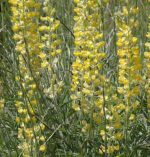 Sulphur lupine is a herbaceous perennial native to the prairies and sagebrush deserts of the foothills and lower mountains from British Columbia to Idaho and Oregon. It is a member of the pea family, Fabaceae, that also includes mimosa, wild indigo, and black locust. Plants grow 15 to 40 inches tall and have a basal cluster of leaves as well as stem leaves that are palmately compound with 9-11 narrow leaflets that are 1-2″ long with acute tips. There are four varieties and some may have hairy leaflets. From late spring through summer, pea-like flowers appear in racemes .4 to 2″ long and may be purple, yellow or white. Each flower is about 1/2″ long and has a double-toothed upper lip, entire lower lip, and a keel that is not reflexed from the side petals. The genus name, Lupinus, is the classical name for the plant derived from the Latin word lupus meaning wolf, and refers to the false belief the plants destroyed the soil. The specific epithet, sulphureus, is the Latin word for sulfurous and refers to the pale yellow color of the flowers of one variety.
Sulphur lupine is a herbaceous perennial native to the prairies and sagebrush deserts of the foothills and lower mountains from British Columbia to Idaho and Oregon. It is a member of the pea family, Fabaceae, that also includes mimosa, wild indigo, and black locust. Plants grow 15 to 40 inches tall and have a basal cluster of leaves as well as stem leaves that are palmately compound with 9-11 narrow leaflets that are 1-2″ long with acute tips. There are four varieties and some may have hairy leaflets. From late spring through summer, pea-like flowers appear in racemes .4 to 2″ long and may be purple, yellow or white. Each flower is about 1/2″ long and has a double-toothed upper lip, entire lower lip, and a keel that is not reflexed from the side petals. The genus name, Lupinus, is the classical name for the plant derived from the Latin word lupus meaning wolf, and refers to the false belief the plants destroyed the soil. The specific epithet, sulphureus, is the Latin word for sulfurous and refers to the pale yellow color of the flowers of one variety.
Type: Herbaceous perennial
Bloom: Racemes of yellow pea-like flowers in summer
Size: 15-40″ H
Light: Full sun
Soil: Average, dry to medium moist, well-drained
Hardiness: Zone 6
Care: Low maintenance
Pests and Diseases: None of significance
Propagation: Seed
Companion Plants: Purple sage, Oregon sunshine, showy penstemon